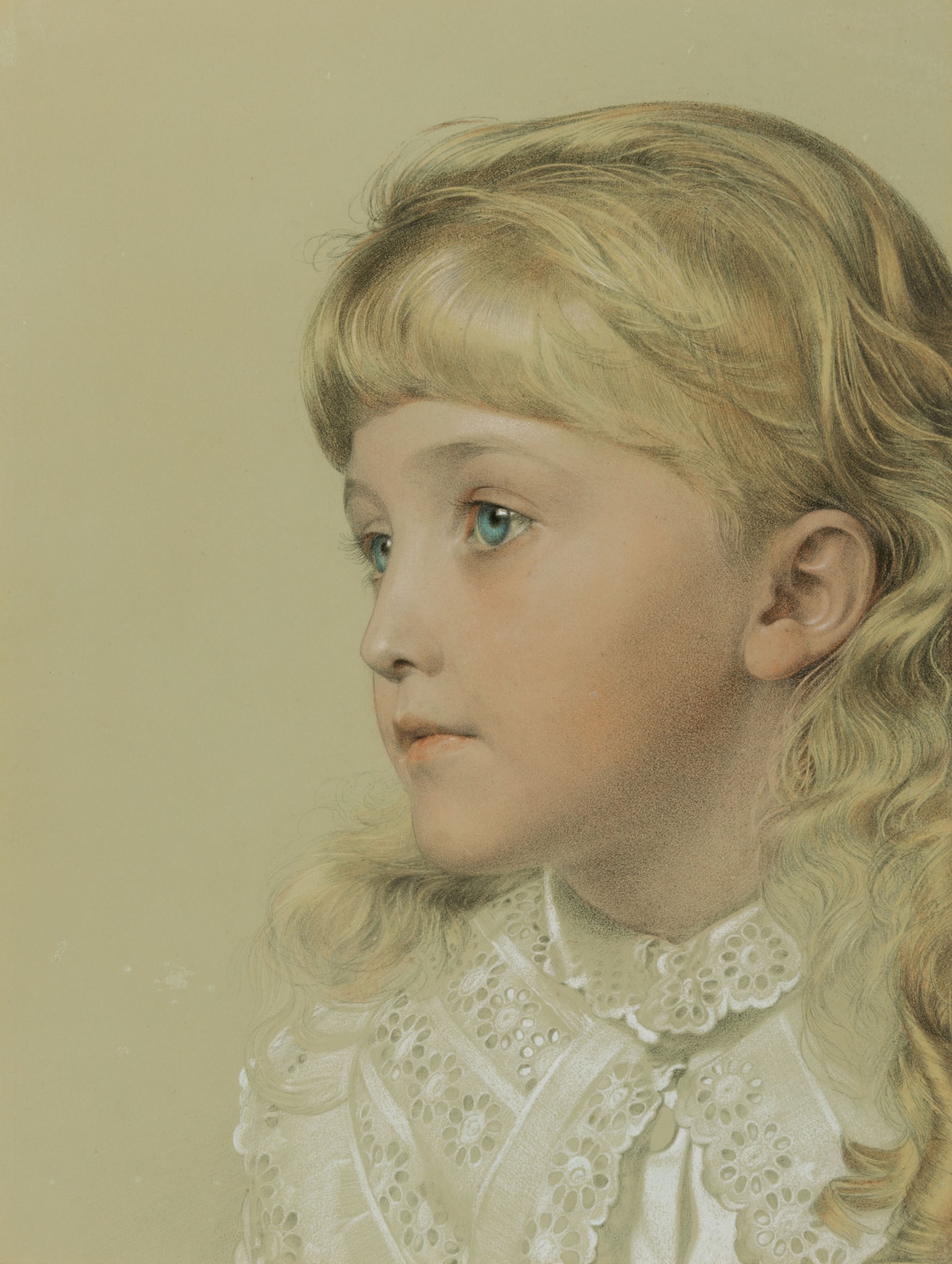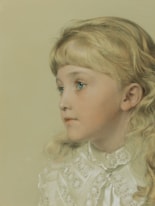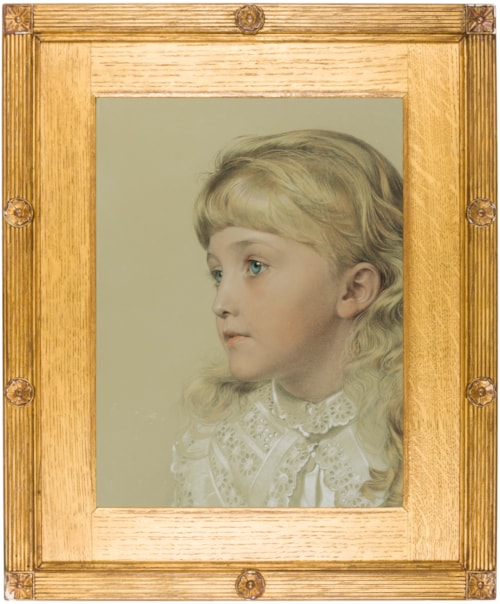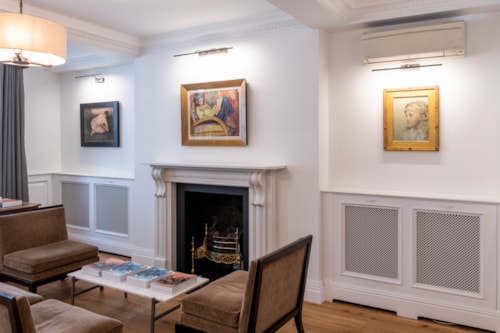Frederick SANDYS
(Norwich 1829 - London 1904)
Portrait of May Gillilan
Coloured chalks and pencil, heightened with white, on pale green tinted paper.
Signed F. Sandys in pencil on part of the original sheet, cut out and pasted onto the reverse of the frame.
377 x 285 mm. (14 7/8 x 11 1/4 in.)
Signed F. Sandys in pencil on part of the original sheet, cut out and pasted onto the reverse of the frame.
377 x 285 mm. (14 7/8 x 11 1/4 in.)
Frederick Sandys was highly regarded in his day as a brilliant draughtsman, and indeed Rossetti once described him as ‘the greatest of all living draughtsmen’. He used coloured chalks for many of his formal portraits, which are characterized by a particular sensitivity and delicacy of touch. As Schoenherr has noted, Sandys was ‘the consummate draughtsman of portraits in coloured chalks…From his student days to the end of his life, the portrait in coloured chalks remained the one constant, his most characteristic mode of expression.’ The artist, who seems to have been short-sighted or myopic, needed to stand very close to his subjects, with the result that many of his portraits evoke an intense focus on the sitter.
Drawn in 1882, this fine portrait drawing was one of several works commissioned from Sandys by the sitter’s father William Gillilan (d.1925) of Kensington in London. Gillilan owned a number of late pictures by the artist, including The Tangled Skein of c.1870 (Ferens Art Gallery, Kingston upon Hull) and Poppies of 1898 (The National Trust, Wightwick Manor, Wolverhampton), as well as a final version of Proud Maisie, dated 1902 (National Gallery of Canada, Ottawa). He also commissioned portraits of his family from Sandys, of which the present sheet is the earliest in date. This drawing was originally created as a double portrait, incorporating a likeness of May Gillilan’s younger sister Winnie at the right of the composition, but was trimmed at the right and bottom edges and reduced to a single portrait sometime between 1997 and 1998. The drawing originally hung in the dining room of the Gillilan home at 6 Palace Gate in Kensington, where it is recorded in a photograph taken in May 1891. Sandys also produced drawn and painted portraits of William Gillilan in 1886 and his wife Mary in 1885, as well as a drawing in coloured chalks of their third and youngest daughter Christabel in 1887.
Drawn in 1882, this fine portrait drawing was one of several works commissioned from Sandys by the sitter’s father William Gillilan (d.1925) of Kensington in London. Gillilan owned a number of late pictures by the artist, including The Tangled Skein of c.1870 (Ferens Art Gallery, Kingston upon Hull) and Poppies of 1898 (The National Trust, Wightwick Manor, Wolverhampton), as well as a final version of Proud Maisie, dated 1902 (National Gallery of Canada, Ottawa). He also commissioned portraits of his family from Sandys, of which the present sheet is the earliest in date. This drawing was originally created as a double portrait, incorporating a likeness of May Gillilan’s younger sister Winnie at the right of the composition, but was trimmed at the right and bottom edges and reduced to a single portrait sometime between 1997 and 1998. The drawing originally hung in the dining room of the Gillilan home at 6 Palace Gate in Kensington, where it is recorded in a photograph taken in May 1891. Sandys also produced drawn and painted portraits of William Gillilan in 1886 and his wife Mary in 1885, as well as a drawing in coloured chalks of their third and youngest daughter Christabel in 1887.
One of the finest draughtsmen of the Pre-Raphaelite circle, Anthony Frederick Augustus Sands (he added the ‘y’ to his surname after his marriage in 1853) was the son of a minor provincial drawing-master. A precocious artist, by the age of ten he was already exhibiting his work in Norwich. At sixteen, while a student at the Norwich School of Design, he met the Reverend James Bulwer, a Norfolk clergyman, antiquarian and amateur artist who became one of his first patrons. Bulwer commissioned several watercolours and drawings from the young artist, culminating several years later in a fine oil portrait, today in the National Gallery of Canada. Despite his lack of a proper academic training, Sandys won a silver medal at the Royal Society of Arts in 1846 for a chalk portrait drawing, and first exhibited at the Royal Academy in 1851, when he showed another chalk portrait. By this time he was living in London, although he continued to divide his time between the capital and Norfolk. He came to be closely associated with the Pre-Raphaelite Brotherhood and for a year shared a studio with Dante Gabriel Rossetti at 16 Cheyne Walk in Chelsea. The 1860s found the artist at his most prolific, producing genre, landscape and subject paintings, commissioned portraits, finished drawings and designs for wood engravings. Like Rossetti, Sandys painted several striking half-length female figures, such as a depiction of Morgan Le Fay of 1864. His close friendship with Rossetti eventually became strained, however, over the latter’s accusation that Sandys had copied one of his designs.
In 1868 his painting Medea was first accepted and then, at the last minute, rejected by the Royal Academy, to the considerable surprise and consternation of both critics and fellow artists. From this point onwards, Sandys only rarely painted in oils, preferring to use coloured chalks for his portraits and subject pictures. As part of the preparatory process for his paintings, he had always made full-scale drawn cartoons in chalk, and these elaborate works ¬- sometimes on a very large scale – began to be offered for sale in their own right. For the remainder of his career the artist developed a particular speciality of producing chalk drawings for collectors, most famously Proud Maisie, of which he made several versions. Sandys also continued to receive numerous private commissions for finished portraits in coloured chalks, while between 1881 and 1885 he made a series of portraits of notable writers for the publisher Alexander Macmillan. As the scholar Douglas Schoenherr has pointed out, ‘Sandys never really attempted to plumb any psychological depth in his portraiture – his forte was a more superficial celebration of features, costume and accessories rendered at their best in a super-refined and elegant technique and with a sure, even quirky sense of design.’ Among his favourite models was his longtime companion, the actress Mary Emma Jones, who was known by her stage name of ‘Miss Clive’. She was the mother of the artist’s ten children, of whom six daughters and two sons survived infancy. Sandys also provided a number of splendid illustrations for wood engravings for books and such magazines as The Cornhill Magazine, Once a Week and Good Words, for which he became very well known.
Largely due to his painstaking technique, Sandys worked very slowly, and produced only a relatively small oeuvre of paintings, drawings and wood engravings. An inveterate gambler and spendthrift, he was often in financial difficulties and was thrice declared bankrupt, although he was supported by such patrons as Cyril Flower, later Baron Battersea, who gave him an allowance and paid for studio expenses. Nevertheless, the last two decades of his life saw a significant reduction in the artist’s output. In 1884 an article on his work appeared in the Art Journal, and in 1896 a monograph devoted to his work was published in a special issue of The Artist magazine. Two years later Sandys became a founder member of the International Society of Sculptors, Painters and Gravers. An exhibition of his drawings was shown, alongside works by Rossetti and Simeon Solomon, at the Leicester Galleries in London in 1904, a few months before the artist’s death. Although a small retrospective memorial exhibition was mounted at the Royal Academy in 1905, his oeuvre soon lapsed into obscurity, and it was not until almost seventy years later that another exhibition of Sandys’s work took place, at the Brighton Art Gallery in 1974.
In 1868 his painting Medea was first accepted and then, at the last minute, rejected by the Royal Academy, to the considerable surprise and consternation of both critics and fellow artists. From this point onwards, Sandys only rarely painted in oils, preferring to use coloured chalks for his portraits and subject pictures. As part of the preparatory process for his paintings, he had always made full-scale drawn cartoons in chalk, and these elaborate works ¬- sometimes on a very large scale – began to be offered for sale in their own right. For the remainder of his career the artist developed a particular speciality of producing chalk drawings for collectors, most famously Proud Maisie, of which he made several versions. Sandys also continued to receive numerous private commissions for finished portraits in coloured chalks, while between 1881 and 1885 he made a series of portraits of notable writers for the publisher Alexander Macmillan. As the scholar Douglas Schoenherr has pointed out, ‘Sandys never really attempted to plumb any psychological depth in his portraiture – his forte was a more superficial celebration of features, costume and accessories rendered at their best in a super-refined and elegant technique and with a sure, even quirky sense of design.’ Among his favourite models was his longtime companion, the actress Mary Emma Jones, who was known by her stage name of ‘Miss Clive’. She was the mother of the artist’s ten children, of whom six daughters and two sons survived infancy. Sandys also provided a number of splendid illustrations for wood engravings for books and such magazines as The Cornhill Magazine, Once a Week and Good Words, for which he became very well known.
Largely due to his painstaking technique, Sandys worked very slowly, and produced only a relatively small oeuvre of paintings, drawings and wood engravings. An inveterate gambler and spendthrift, he was often in financial difficulties and was thrice declared bankrupt, although he was supported by such patrons as Cyril Flower, later Baron Battersea, who gave him an allowance and paid for studio expenses. Nevertheless, the last two decades of his life saw a significant reduction in the artist’s output. In 1884 an article on his work appeared in the Art Journal, and in 1896 a monograph devoted to his work was published in a special issue of The Artist magazine. Two years later Sandys became a founder member of the International Society of Sculptors, Painters and Gravers. An exhibition of his drawings was shown, alongside works by Rossetti and Simeon Solomon, at the Leicester Galleries in London in 1904, a few months before the artist’s death. Although a small retrospective memorial exhibition was mounted at the Royal Academy in 1905, his oeuvre soon lapsed into obscurity, and it was not until almost seventy years later that another exhibition of Sandys’s work took place, at the Brighton Art Gallery in 1974.
Provenance
Commissioned from the artist by the sitter’s father, William Gillilan, Kensington, London
Thence by descent
Anonymous sale, Salisbury, Woolley and Wallis, 15 April 1996, lot 85
Anonymous sale, London, Bonhams Knightsbridge, 19 March 1997, lot 106
The Maas Gallery, London, in 1998
Private collection.
Thence by descent
Anonymous sale, Salisbury, Woolley and Wallis, 15 April 1996, lot 85
Anonymous sale, London, Bonhams Knightsbridge, 19 March 1997, lot 106
The Maas Gallery, London, in 1998
Private collection.
Literature
Betty Elzea, Frederick Sandys 1829-1904: A Catalogue Raisonné, Woodbridge, 2001, pp.267-268, no.4.27.
Exhibition
London, Maas Gallery, British Pictures (1840-1940), 1998, no.39.







